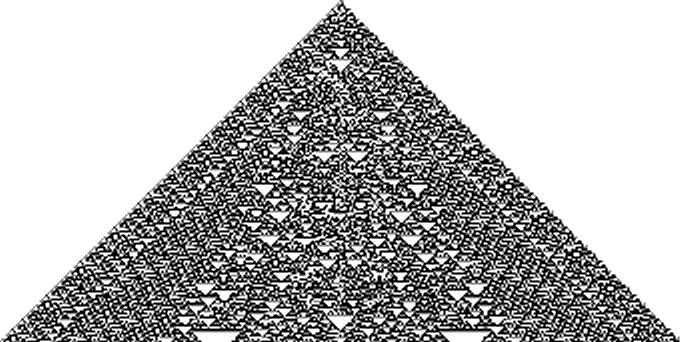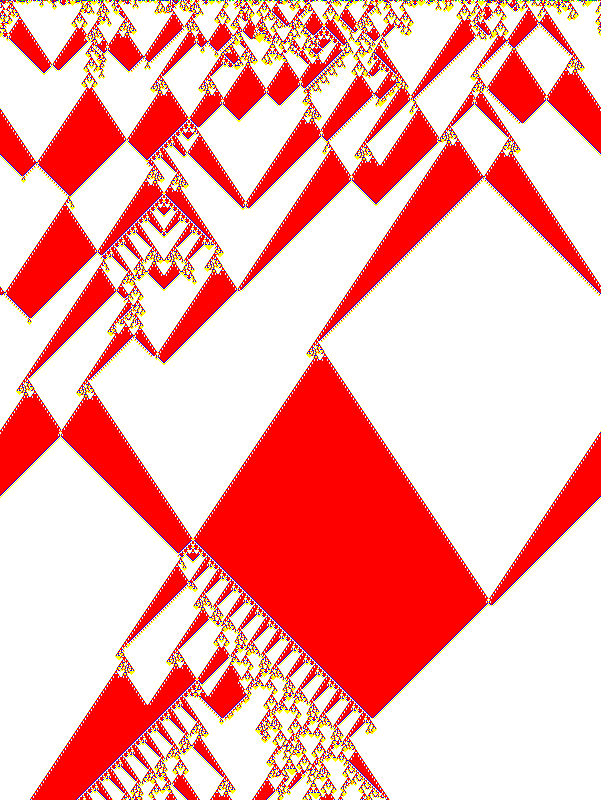|
Dissymetry as a dynamic component of artwork
Besides the static component (symmetry, conservation), a dynamic component is also present in every work of art. It is the principle of change or variation which we may call the evolutionary principle. As with living organisms, dissymetry represents a moving force, a life principle. In the words of M.C. Corballis (1990, p. 183), "an ideally symmetric being would not be able to differentiate between right and left." The human brain is characterized by morphological symmetry and functional asymmetry. In the cellular automata a minimal violation of symmetry and the appearance of a "defect" leads to an abundance and variety of structures resulting from a minimally altered initial state of the system (Fig. 9.15) (Pickover, 1989).
Figure 9.15 A graphic interpretation of "cellular automata". In the psychology of perception the dynamic principle is defined as a motivation factor of optimum activity. The perceptive system rejects extremes - extremely simple stimuli (with a low arousal level) as well as extremely complex ones (with a high level of arousal) and is directed at moderately complex stimuli. Because of its low information level, strict repetition causes a decrease in the motivation and attention of the observer. Variety induces the observer to search and stimulates his intellectual curiosity (" variatio delectat"). A copy of J.S. Bach's Misikalisches Opfer dedicated to King Friedrich begins with the inscription, Regis Iussu Cantio Et Reliqua Canonica Arte Resoluta ("At the King's command, the song and the remainder resolved with canonic art"). In the words of D. Hofstadter (1980), it is no wonder that namely the term ricercar ("to seek", "to research") denotes one of the most perfect musical forms, "the erudite form of the fugue, perhaps too ascetically intellectual for the average listener." Within the scope of the visual arts the classification of symmetries into "static" and "dynamic" is really the classification into mirror symmetry and other forms of symmetry which, because of their translational or rotational component suggest movement, introducing a subjective temporal component into the objectively static space of painting. An illustrative example of the attempts to convey movement are the works of Italian futurists or of M. Duchamp (Fig. 9.16). Figure 9.16. M. Duchamp, Nude going down the stairs. The visual space of a work of graphic art is oriented, i.e., assymetric. Its orientation is given by a natural coordinate system of a vertical and horizontal axis, where the vertical (gravitational) y-axis of symmetry represents the dominant visual factor ("a magnet for the eye," according to E. M. Gombrich, 1979). On the other hand, the horizontal x-axis can also be an axis of symmetry (e.g., an image and its reflection on water), but it is most frequently the axis of translation on which movements occur. The vertical axis is not only the mirror axis of symmetry of individual objects in visual space but also the axis of symmetry of its implicit coordinate system. In this manner the concept of "static" symmetry denotes a type of symmetry that is in harmony with the symmetry of the system itself. In temporal arts, especially in music and poetry, the horizontal axis of the natural coordinate system is the time axis. The vertical axis corresponds to the tonal pitch. This is why the concept of static symmetry in temporal arts refers to transformations which are always invariant in regards to the course of time: repetition (rhyme in poetry) and, up to a certain point, transposition. Mirror reflection, as a static organizational principle can fulfill its true role only on the holistic level, i.e., at the moment when, upon listening to a musical piece or reading a literary work, we are capable of perceiving the work as a whole. Just as a ground plan of a building remains hidden from the eye of the observer and can be reconstructed only after the building has been surveyed from all sides, the form of a musical piece is accessible to the listener only after he has finished listening to it. The movement on the y-axis by an ascending sequence of tonal pitches suggests another dynamic component - conquering gravity. This is why it is quite justified to speak of the "geometry of music" or "musical space." Both of these concepts suggest a deep connection of music and geometry. The words of F. Warrain, "Music is to Time what Geometry is to Space," or Goethe, "Geometry is frozen music," only emphasize this connection (Ghyka, 1987, p. 400). Namely because of the difficulty in perceiving other symmetries (e.g., inversion, retrograde inversion, etc.) they will represent local symmetries which connect the continued or temporally close parts of the musical piece. Unlike visual arts which allow an instantaneous perception of the work as a whole, in temporal arts a specific type of symmetry in time occurs - predictability. From the aspect of symmetry predictability is a form of invariance in time: equal or similar causes have corresponding equal or similar effects (Rosen, 1989). Temporal predictability and reproducibility (the repetition of experiments) are fundamental properties of all sciences. By following the course of the musical piece, the listener performs a temporal extrapolation based on the principle of continuity, thus predicting the course of the musical episode. This is where the heuristic component of music is fully expressed. An attempt for a parallel analysis of both components, the static and the dynamic, has been made by contemporary generalizations of the theory of symmetry: antisymmetry ("black - white", or bivalent symmetry) and colored (polyvalent) symmetry. Antisymmetry (bivalent symmetry) allows the possibility of studying symmetry structures in which all equivalent elements may be divided into two classes (i.e., "black" and "white"). The symmetry which makes possible the transition from an element in one class to an element from another class is accompanied by a change in the corresponding bivalent property (in this case, color) (Shubnikov and Koptsik, 1972, Washburn and Crowe, 1988). In visual arts, especially in black and white ornamental art, alternating colors is used as an art tool for the expression of contrast, duality and the suggestion of space (Fig. 9.17).
Figure 9.17. S.E. Kim, Image-image, an example of the equivalency of the figure and the ground.
|






